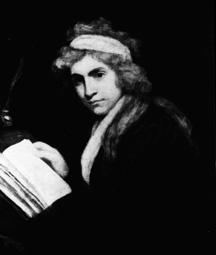Mary Wollstonecraft (1759-1797)

Wollstonecraft
Time Line
|
1759 |
April
27, Wollstonecraft was born in London to John Edward Wollstonecraft and
Elizabeth Dickson. She had an older brother, Edward and four other
children, James, Charles, Eliza and Everina were born after her. |
|
1759-1768 |
The Wollstonecraft family moves frequently
during this time. John Edward attempts farming in Epping, Whalebone, and Essex. |
|
1768 |
The
Wollstonecraft family moves to a farm in Yorkshire. Mary's education followed
the common course of day-school. But, she also becomes friends
with a neighboring clergyman, Mr. Clare. It is at Mr. Clare's home where she begins to develop intellectually. |
|
1775 |
Wollstonecraft meets Francis (Fanny) Blood, who
became her closest friend and companion until Blood's death. |
|
1776 |
The Wollstonecraft family moves again to a farm
in Wales. |
|
1777 |
The
Wollstonecraft family returns to London. Mary, at eighteen was able to exert
some pressure upon her father to live in the village of Walworth which was
near London and her friend, Fanny Blood. She also insisted upon a room of her own for quiet and study. |
|
1778 |
Wollstonecraft leaves the family home to become
a companion to Widow Dawson of Bath. |
|
1780 |
Wollstonecraft is called home to be with her
failing mother. |
|
1782 |
Elizabeth
Dickson Wollstonecraft dies. Mary's sister, Eliza marries Meredith Bishop. Mary
moves in with Fanny Blood. |
|
1784 |
Wollstonecraft
is called to nurse her sister Eliza who is apparently deranged from the
difficult birth of her daughter
and some sources say, the abuse of the husband. Wollstonecraft, Fanny Blood,
and Eliza open a school in
Islington where they are joined by the other Wollstonecraft sister, Everina.
Wollstonecraft becomes acquainted with Dr. Richard Price and other liberals. |
|
1785 |
24
of February, Fanny Blood marries Hugh Skeys in Lisbon. She becomes pregnant
and sends for Wollstoncraft. |
|
1786 |
Wollstonecraft
returns to England to find the school had suffered from her absence. She
closes the school and writes her first work, a pamphlet entitled Thoughts
on the Education of Daughters. She then accepts the position of governess to the daughters of Lord Viscount
Kingsborough and moves to Ireland to fulfill her duties. |
|
1788 |
Wollstonecraft
spends the summer with the Kingsborough family at Bristol Hot-Wells. She
writes her first book, Mary, a Fiction, a children's book,
Original Stories from Real Life, and translates Jacques Necker's On The
Importance Of
Religious Opinions.
She also becomes involved in her publisher, Joseph Johnson's monthly
periodical The
Analytical Review
as well as beginning translation of Christian Gotthilf Salzmann's Elements
Of Morality For The Use Of Children. Her work with Salzman's book led to correspondence and a later
reciprocation when Salzmann translated
her A Vindication of The Rights of Woman. |
|
1789 |
Johnson publishes Wollstonecraft's The Female
Reader, no copies of which have apparently survived. |
|
1790 |
Wollstonecraft
completes and publishes her translation of Salzmann's Elements..., writes A
Vindication Of The Rights Of Men in response to Edmund Burke's Reflections on The Revolution In France. |
|
1791 |
of The Rights of Woman. She meets William Godwin several times over
the course of the year, but neither party is impressed with the other. |
|
1792 |
A Vindication of The Rights of Woman is published by Johnson. Leaves for France. |
|
1793 |
Meets
Gilbert Imlay, an American businessman. Moves to the suburbs of Paris for
safety. By the end of the year, Wollstonecraft is attached to Imlay yet does
not marry him, preferring instead to simply register as his wife at the
American Embassy in Paris for protection purposes. Wollstonecraft and Imlay
move back into Paris together. Wollstonecraft
becomes pregnant. Imlay leaves for Le Havre on a business trip. |
|
1794 |
Wollstonecraft
travels to Le Havre to join Imlay. Daughter Fanny is born May 14. Imlay
returns to Paris and is followed
by Wollstonecraft and Fanny a short time later. Imlay leaves Wollstonecraft
and Fanny and travels to London. Johnson publishes her Historical
and Moral View Of The Origin and Progress of The French Revolution. |
|
1795 |
Wollstonecraft
takes her daughter and follows Imlay to London. On discovering his
infidelity, she begins to contemplate suicide. Imlay thwarts her first
attempt. Wollstonecraft leaves on a business trip for Imlay with her
child and a nurse to Sweden Norway and Denmark. She returns to find Imlay
involved with an actress and attempts suicide by jumping off Putney
Bridge. |
|
1796 |
Letters
Written During a Short Residence in Sweden, Norway, and Denmark, is published by Johnson. Wollstonecraft meets William
Godwin again and the two become lovers. |
|
1797 |
29
March, Wollstonecraft and Godwin marry in a private ceremony due to
Wollstonecraft's pregnancy. They announce
their marriage in April. The two maintained separate quarters to work in
during the day, but entertained guests
in the evening at No. 29 The Polygon. |
|
1798 |
Goodwin's book Memoirs of Mary
Wollstonecraft is published. |
Wollstonecraft Electronic Text:
A Vindication of the Rights of Woman
Suggested
Readings available at OSU
·
Todd,
Janet M.,Mary Wollstonecraft: An Annotated Bibliography;
·
Goodwin,
William. Memoirs of Mary Wollstonecraft:
·
Stenton,
Doris Mary, The English Woman In History.
The
Valley Library has the bulk of Wollstonecraft's major works as well as several
biographies. Not yet available at the
Valley
Library is the new critical edition edited by Carol H. Poston,A Vindication
of the Rights of Woman.
Sources for the Wollstonecraft Time Line
URL: http://oregonstate.edu/instruct/phl302/philosophers/wollstonecraft.html
The information has been taken
on 31st of October 2008
OTHER INTERESTING CHRONOLOGIES
Página creada y
actualizada por grupo "mmm".
Para
cualquier cambio, sugerencia, etc. contactar con: lucaca@alumni.uv.es
©
a.r.e.a./Dr.Vicente Forés López
Universitat
de València Press
Página
creada: 28/10/08 actualizada: 03/11/08
